Poul Henningsen Early and large ‘Septima’ ceiling light, type 5 1927-1928 Tubular copper, copper, patinated brass, coloured and opaque glass. 49.6 cm (19 1/2 in.) diameter, 81.4 cm (32 in.) drop Manufactured by Louis Poulsen, Copenhagen, Denmark. Inside of light fixture impressed with PAT. APPL..
Provenance Private collection, Jutland, circa 1930 Acquired from the above by the present owner, 2010 Literature Nyt Tidsskrift For Kunstindustri, no. 1, January 1928, p. 203 Åke Stavenow, ‘BO’s “Efteraars-udstilling”’, Form, 1935, p. 164 Grete Jalk ed., Dansk Møbelkunst gennem 40 aar, Volume 2: 1937-1946, Copenhagen, 1987, p. 171 Tina Jørstian and Poul Erik Munk Nielsen, PH 100 Light&Design, exh. cat., Danish Museum of Art & Design, Copenhagen, 1994, p. 15 Tina Jørstian and Poul Erik Munk Nielsen, eds., Light Years Ahead: The Story of the PH Lamp, Copenhagen, 2000, pp. 181, 237-39 for images and a technical drawing Catalogue Essay The present lot, manufactured before the PH-Lamp received its patent, is a rare example of an amber ‘Septima’ ceiling light produced in a large configuration. The Lights of Poul Henningsen Marcus McDonald Poul Henningsen and his manufacturer Louis Poulsen applied under Danish law on 4th December 1925 for the patent titled ‘Refector for Incandescent Lamp’, which was granted on 19th May 1928 with the Danish patent number 38897 and then by the USA patent ofce 6th May 1930. The specifcs of the patent included a technical drawing and stated the characteristics of the invention: “A refector for difusing the light of incandescent lamps comprising a plurality of concentric downwardly concave shades disposed above and below the plane of the source of light, the inner surfaces of said shades being directed toward the source of light, the surfaces of said shades making at all points angles less than 45 with a line to the source of light, the inner surfaces of the shades being dulled.” Regarding Henningsen’s reliance upon patent law and copyright law, Stina Teilmann-Lock writes “the lamp has been defned, respectively, as both ‘industrial property’ and ‘artistic property’; as an invention and as a work of art.” Prior to the patent being granted, Henningsen was awarded by the jury of the 1925 World’s Fair in Paris, L’Exposition Internationale des Arts Décoratifs et Industriels Modernes, a gold medal and Louis Poulsen silver for their lighting. Presented at the exposition was the ‘Paris’ ceiling light (lot 31), which can be considered the progenitor for the “system of lamp shades that completely surround the source of light so that no radiating rays can meet the eye directly.” Henningsen developed his ‘system of shades’ into types, which ranged from smallest to largest, and were available in different types of glass and painted copper. The shades were then applied to various lighting formats, including: the Standard lamp (lot 10); the exquisite and elegantly designed ‘Piano’ lamp (lot 19); the ‘Academy’ chandelier (lot 49); and the Early table lamp (lot 50). Henningsen’s designs were also used in many prestigious interiors including ceiling lights for the ‘Villa Tugendhat’, designed by Ludwig Mies van der Rohe However, there were ‘system of shades’, such as the Pair of early and rare ceiling lights (lot 28), produced in opaque glass with a painted gold rim, which outshone others. Henningsen design process develops further and he discusses the ‘Spiral’ ceiling light (lot 13), designed for the University of Aarhus, in LP Nyt, which was a publication by Henningsen’s lighting manufacturer Louis Poulsen. In the article he states “The principle in this lamp is much the same as in the PH-lamp and the Globe per se, but the light ray direction is reminiscent of the way it shines outwards from the Globe. The shape is geometric and the light strikes all the parts of the spiral which are illuminated at the same angle refecting it out into the room in the same way.” More than ninety years afer L’Exposition Internationale des Arts Décoratifs et Industriels Modernes, Henningsen’s work still resonates, and the “PH lamp” continues to be “an exceedingly beautiful light” (Poul Henningsen LP Nyt, December 1941). The selected lots are from a curated collection of early important works, which are exceptional in age, scale, condition
Poul Henningsen Early and large ‘Septima’ ceiling light, type 5 1927-1928 Tubular copper, copper, patinated brass, coloured and opaque glass. 49.6 cm (19 1/2 in.) diameter, 81.4 cm (32 in.) drop Manufactured by Louis Poulsen, Copenhagen, Denmark. Inside of light fixture impressed with PAT. APPL..
Provenance Private collection, Jutland, circa 1930 Acquired from the above by the present owner, 2010 Literature Nyt Tidsskrift For Kunstindustri, no. 1, January 1928, p. 203 Åke Stavenow, ‘BO’s “Efteraars-udstilling”’, Form, 1935, p. 164 Grete Jalk ed., Dansk Møbelkunst gennem 40 aar, Volume 2: 1937-1946, Copenhagen, 1987, p. 171 Tina Jørstian and Poul Erik Munk Nielsen, PH 100 Light&Design, exh. cat., Danish Museum of Art & Design, Copenhagen, 1994, p. 15 Tina Jørstian and Poul Erik Munk Nielsen, eds., Light Years Ahead: The Story of the PH Lamp, Copenhagen, 2000, pp. 181, 237-39 for images and a technical drawing Catalogue Essay The present lot, manufactured before the PH-Lamp received its patent, is a rare example of an amber ‘Septima’ ceiling light produced in a large configuration. The Lights of Poul Henningsen Marcus McDonald Poul Henningsen and his manufacturer Louis Poulsen applied under Danish law on 4th December 1925 for the patent titled ‘Refector for Incandescent Lamp’, which was granted on 19th May 1928 with the Danish patent number 38897 and then by the USA patent ofce 6th May 1930. The specifcs of the patent included a technical drawing and stated the characteristics of the invention: “A refector for difusing the light of incandescent lamps comprising a plurality of concentric downwardly concave shades disposed above and below the plane of the source of light, the inner surfaces of said shades being directed toward the source of light, the surfaces of said shades making at all points angles less than 45 with a line to the source of light, the inner surfaces of the shades being dulled.” Regarding Henningsen’s reliance upon patent law and copyright law, Stina Teilmann-Lock writes “the lamp has been defned, respectively, as both ‘industrial property’ and ‘artistic property’; as an invention and as a work of art.” Prior to the patent being granted, Henningsen was awarded by the jury of the 1925 World’s Fair in Paris, L’Exposition Internationale des Arts Décoratifs et Industriels Modernes, a gold medal and Louis Poulsen silver for their lighting. Presented at the exposition was the ‘Paris’ ceiling light (lot 31), which can be considered the progenitor for the “system of lamp shades that completely surround the source of light so that no radiating rays can meet the eye directly.” Henningsen developed his ‘system of shades’ into types, which ranged from smallest to largest, and were available in different types of glass and painted copper. The shades were then applied to various lighting formats, including: the Standard lamp (lot 10); the exquisite and elegantly designed ‘Piano’ lamp (lot 19); the ‘Academy’ chandelier (lot 49); and the Early table lamp (lot 50). Henningsen’s designs were also used in many prestigious interiors including ceiling lights for the ‘Villa Tugendhat’, designed by Ludwig Mies van der Rohe However, there were ‘system of shades’, such as the Pair of early and rare ceiling lights (lot 28), produced in opaque glass with a painted gold rim, which outshone others. Henningsen design process develops further and he discusses the ‘Spiral’ ceiling light (lot 13), designed for the University of Aarhus, in LP Nyt, which was a publication by Henningsen’s lighting manufacturer Louis Poulsen. In the article he states “The principle in this lamp is much the same as in the PH-lamp and the Globe per se, but the light ray direction is reminiscent of the way it shines outwards from the Globe. The shape is geometric and the light strikes all the parts of the spiral which are illuminated at the same angle refecting it out into the room in the same way.” More than ninety years afer L’Exposition Internationale des Arts Décoratifs et Industriels Modernes, Henningsen’s work still resonates, and the “PH lamp” continues to be “an exceedingly beautiful light” (Poul Henningsen LP Nyt, December 1941). The selected lots are from a curated collection of early important works, which are exceptional in age, scale, condition

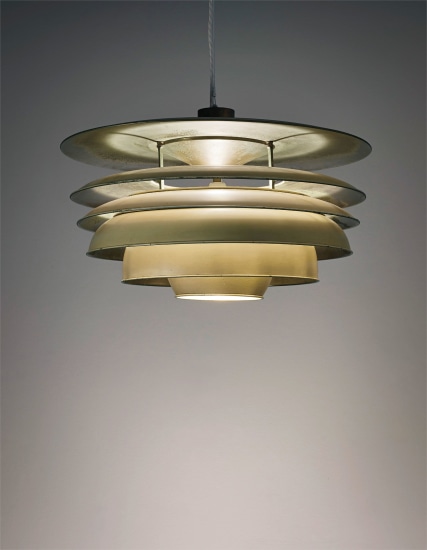

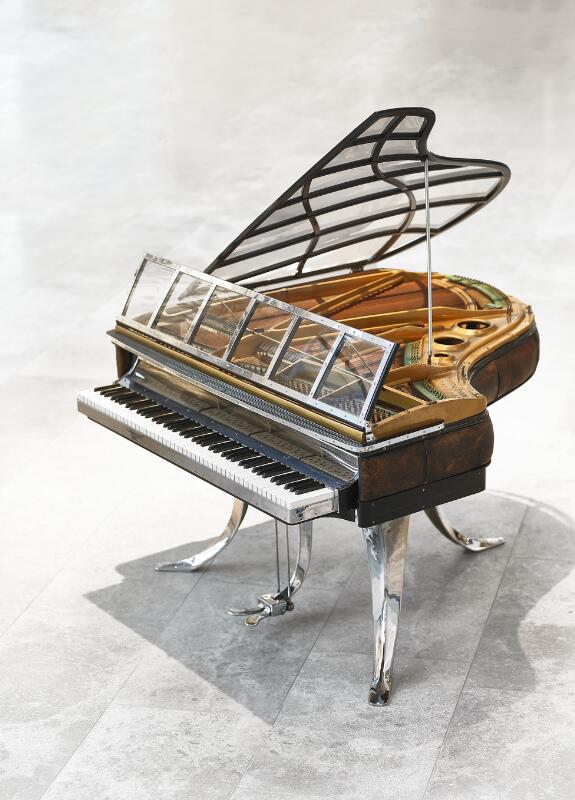

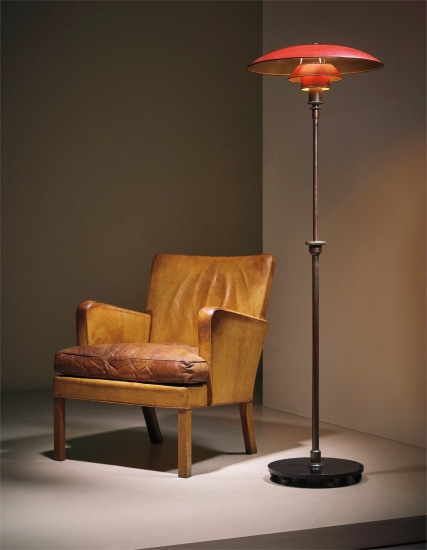
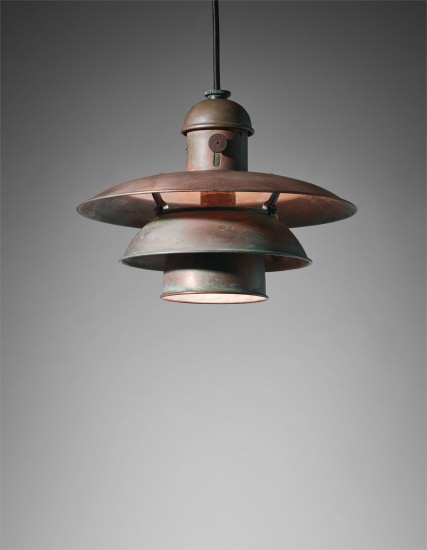
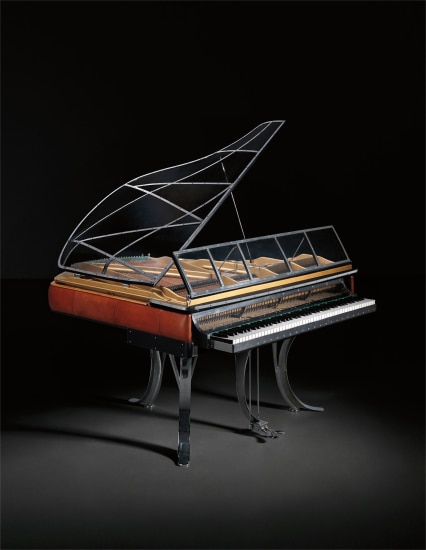




Try LotSearch and its premium features for 7 days - without any costs!
Be notified automatically about new items in upcoming auctions.
Create an alert